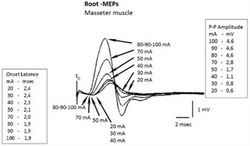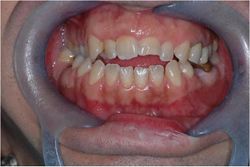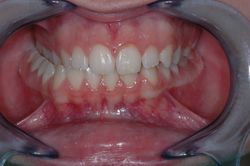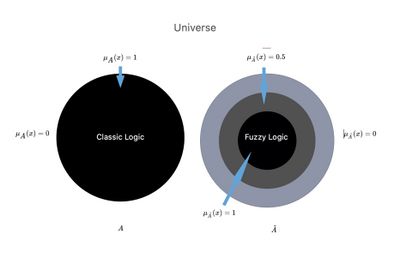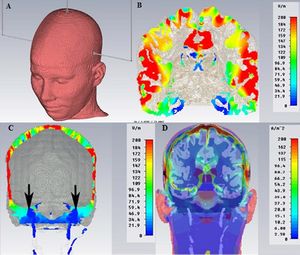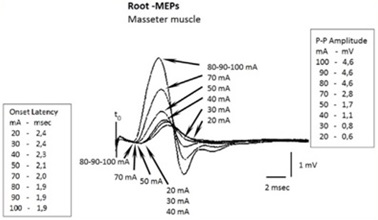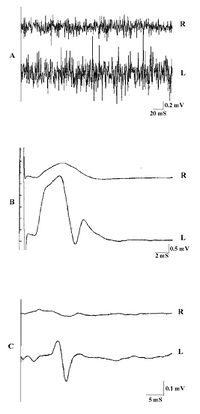Difference between revisions of "Systemlogik"
Gianfranco (talk | contribs) m (Text replacement - "Kralove" to "Králové") |
|||
| Line 1: | Line 1: | ||
[[File:Potenziale Evocato della Radice Trigeminale.jpg|Motor Evoked Potential of the ipsilateral Trigeminal Root |alt=|250px|left]] | |||
Dieses Kapitel schließt den Kreis der 'Logik der medizinischen Sprache', um ein diagnostisches Modell im Bereich der Kau- und Schluckfunktionen einzuführen, das die Konzeptualität der Systemlogik mit der Quantenmechanik kombiniert. Die statistisch-mathematischen Modelle einer Systemlogik können daher weder subjektiv noch approximativ sein, geschweige denn vage und informell im Kontext des klinischen Modells. Um diese Eigenschaften zu erlangen, ist es notwendig, die Grundkonzepte der 'Systemtheorie' zu berücksichtigen. | |||
Der unbestreitbare diagnostische Durchbruch in den meisten medizinischen Disziplinen liegt in der Bioingenieurwissenschaft, den technologischen Fortschritten und speziell in der Systemtheorie. Diese ermöglicht es, den Zustand eines Systems zu überprüfen, indem die Ausgangsvariablen mit den Eingangsvariablen verglichen werden. Dieser enorme Fortschritt liegt in der Einführung des Triggerkonzepts. Die Bioingenieurwissenschaft im trigeminalen elektrophysiologischen Kontext hat die Verwendung einer Reihe von Triggern ermöglicht (transkranielle elektrische Stimulation, transkranielle magnetische Stimulation, mechanische Stimulation des trigeminalen Gebiets), die es uns ermöglichen, das System mit einer viel höheren Auflösung zu testen als ohne das Reagieren auf einen externen Trigger. Ein weiteres Schlüsselelement ist, dass das Triggermodell viele Jahre vor dem Auftreten eines offensichtlichen pathologischen klinischen Zeichens einen Momentaufnahme des Systemzustands liefern kann. | |||
In | In diesem Kapitel werden einige grundlegende Schritte erläutert, die bei der Modellierung diagnostischer Methoden nach den Grundsätzen der Systemtheorie zu beachten sind. | ||
{{ArtBy| | {{ArtBy| | ||
| Line 28: | Line 16: | ||
| autore7 = Irene Minciacchi | | autore7 = Irene Minciacchi | ||
}} | }} | ||
==Vorwort== | |||
== | |||
Warum sind wir zur 'Systemlogik' gelangt? Die Schritte sind weder trivial noch persönlich, und um den Mehrwert der 'Systemlogik' wahrzunehmen, müssen wir zwangsläufig zwei wesentliche Gründe erwähnen, die diesen Weg geprägt haben: den der zahnärztlichen klinischen Indizes und den der Logik der medizinischen Sprache. | |||
=== | ===Zahnärztliche klinische Indizes=== | ||
Es gibt "Indizes", die als Elemente der Systemlogik betrachtet werden können, da sie objektive Daten liefern, wie z.B. die "Henderson-Hasselbalch-Gleichung" (für die Blut-pH-Analyse) und andere "Indizes", die in verschiedenen medizinischen Disziplinen entwickelt wurden.<ref>{{cita libro | |||
| autore = Xiao W | | autore = Xiao W | ||
| autore2 = Yang Y | | autore2 = Yang Y | ||
| Line 104: | Line 90: | ||
| LCCN = | | LCCN = | ||
| OCLC = | | OCLC = | ||
}}</ref> | }}</ref> | ||
Ein Test, ein normatives Referenzdatum oder ein "Index" (sowie eine "Konstante") sind Strategien, die mit mathematisch-statistischen Modellen verbunden sind und Daten generieren. Diese Daten sind für die Genauigkeit der Diagnose, für die differenzielle Diagnose sowie für die therapeutischen Leitlinien unerlässlich. Auf diesen Referenzdaten basieren in der wissenschaftlichen Zahnmedizingeschichte Implementierungen und Modifikationen, aber auch Unsicherheiten und Überzeugungen, die in Form von Axiomen oder Denkschulen Richtlinien festgelegt haben, die nicht immer wissenschaftlich gerechtfertigt und manchmal sogar unrichtig sind. | |||
===In | ===In der Literatur=== | ||
Wir können die in der Literatur gemeldeten Daten in Bezug auf die untersuchten "Indizes" bei Patienten mit "Temporomandibulären Störungen"<ref>Results in [https://pubmed.ncbi.nlm.nih.gov PubMed] for "[https://pubmed.ncbi.nlm.nih.gov/?term=%22temporomandibular+disorders+index%22&filter=datesearch.y_1 Temporomandibular disorders Index]"</ref> berücksichtigen oder genauer gesagt die Themen der klinischen Indizes in orthodontischen Disziplinen überprüfen.<ref>Results in [https://pubmed.ncbi.nlm.nih.gov PubMed] for "[https://pubmed.ncbi.nlm.nih.gov/?term=%22orthodontics%20index%22&filter=simsearch2.ffrft&filter=datesearch.y_1 Orthodontics Indexes]"</ref> | |||
In | In einem kürzlich erschienenen Artikel von Andrea Scribante und Kollegen<ref>{{cita libro | ||
| autore = Sfondrini MF | | autore = Sfondrini MF | ||
| autore2 = Zampetti P | | autore2 = Zampetti P | ||
| Line 133: | Line 119: | ||
| LCCN = | | LCCN = | ||
| OCLC = | | OCLC = | ||
}}</ref> | }}</ref> werden beispielsweise die folgenden Absätze abgeleitet: | ||
#Die Einleitung besagt, dass die Bewertung der Ergebnisse der kieferorthopädischen Behandlung traditionell auf der Erfahrung und den subjektiven Meinungen der Kliniker beruht.<ref>{{cita libro | |||
# | |||
| autore = Dyken RA | | autore = Dyken RA | ||
| autore2 = Sadowsky PL | | autore2 = Sadowsky PL | ||
| Line 153: | Line 138: | ||
| LCCN = | | LCCN = | ||
| OCLC = | | OCLC = | ||
}}</ref> | }}</ref> In diesem ersten Absatz wird das Limit des ausgedrückten Konzepts verstanden, nämlich dass ein diagnostischer Test und/oder eine therapeutische Leitlinie niemals wissenschaftlich anhand subjektiver Parameter bewertet werden sollten. | ||
# | #Jedoch wurden seit den 1990er Jahren spezifische Indizes entwickelt, um die Gesundheitsergebnisse objektiv zu bewerten, indem die Qualität der Behandlung analysiert wird.<ref name=":0">{{cita libro | ||
| autore = Richmond S | | autore = Richmond S | ||
| autore2 = Shaw WC | | autore2 = Shaw WC | ||
| Line 177: | Line 162: | ||
| LCCN = | | LCCN = | ||
| OCLC = | | OCLC = | ||
}}</ref> | }}</ref> Diese Indizes vergleichen Vor- und Nachbehandlungsdaten, um das Ergebnis der kieferorthopädischen Therapie zu bestimmen<ref>{{cita libro | ||
| autore = Onyeaso CO | | autore = Onyeaso CO | ||
| autore2 = BeGole EA | | autore2 = BeGole EA | ||
| Line 194: | Line 179: | ||
| LCCN = | | LCCN = | ||
| OCLC = | | OCLC = | ||
}} - ''[https://grortho.gr/associations-between-pretreatment-age-and-treatment-time-with-orthodontic-treatment-outcome-a-comparison-by-means-of-two-orthodontic-indices/?lang=en see also]''</ref> | }} - ''[https://grortho.gr/associations-between-pretreatment-age-and-treatment-time-with-orthodontic-treatment-outcome-a-comparison-by-means-of-two-orthodontic-indices/?lang=en see also]''</ref> und die Qualität zukünftiger Behandlungen zu verbessern. Dieser zweite wissenschaftlich akzeptable Absatz hebt den Zweck der "Indizes" hervor, nämlich den Vorher-Nachher-Vergleich.<ref>{{cita libro | ||
| autore = Hickman JH | | autore = Hickman JH | ||
| titolo = Directional edgewise orthodontic approach. 5 | | titolo = Directional edgewise orthodontic approach. 5 | ||
| Line 210: | Line 195: | ||
| LCCN = | | LCCN = | ||
| OCLC = | | OCLC = | ||
}}</ref> | }}</ref> Es ist jedoch wichtig zu berücksichtigen, wer festlegt, dass der Zustand nach der Behandlung als "Normokklusion" betrachtet wird, während der Zustand vor der Behandlung als "Malokklusion" im Sinne der Zahnstellung kategorisiert wird? | ||
# | #Der am häufigsten verwendete Index zur Bewertung des Erfolgs von kieferorthopädischen Maßnahmen ist der Peer Assessment Rating Index (PAR), der entwickelt wurde, um zu messen, wie weit sich ein Patient von einer normalen Okklusion und Ausrichtung entfernt.<ref name=":0" /> Dieser Index wurde verwendet, um die Auswirkungen der Therapie in verschiedenen Situationen zu bewerten: die Verwendung von festen und mobilen Geräten,<ref>{{cita libro | ||
| autore = Firestone AR | | autore = Firestone AR | ||
| autore2 = Häsler RU | | autore2 = Häsler RU | ||
| Line 229: | Line 214: | ||
| LCCN = | | LCCN = | ||
| OCLC = | | OCLC = | ||
}}</ref> | }}</ref> den Vergleich der kieferorthopädischen Behandlung zwischen privaten Praxen und kieferorthopädischen Schulen,<ref>{{cita libro | ||
| autore = Cook DR | | autore = Cook DR | ||
| autore2 = Harris EF | | autore2 = Harris EF | ||
| Line 247: | Line 232: | ||
| LCCN = | | LCCN = | ||
| OCLC = | | OCLC = | ||
}}</ref> | }}</ref> die Bewertung der okklusalen Stabilität nach kieferorthopädischer Behandlung,<ref>{{cita libro | ||
| autore = Ramanathan C | | autore = Ramanathan C | ||
| titolo = PAR index in the evaluation of the stability of the orthodontic treatment results. A review | | titolo = PAR index in the evaluation of the stability of the orthodontic treatment results. A review | ||
| Line 263: | Line 248: | ||
| LCCN = | | LCCN = | ||
| OCLC = | | OCLC = | ||
}}</ref> | }}</ref> frühzeitige Behandlungen<ref>{{cita libro | ||
| autore = Pangrazio-Kulbersh V | | autore = Pangrazio-Kulbersh V | ||
| autore2 = Kaczynski R | | autore2 = Kaczynski R | ||
| Line 281: | Line 266: | ||
| LCCN = | | LCCN = | ||
| OCLC = | | OCLC = | ||
}}</ref> | }}</ref> und Ergebnisse kieferorthopädischer Chirurgie.<ref>{{cita libro | ||
| autore = Templeton KM | | autore = Templeton KM | ||
| autore2 = Powell R | | autore2 = Powell R | ||
| Line 301: | Line 286: | ||
| LCCN = | | LCCN = | ||
| OCLC = | | OCLC = | ||
}}</ref> | }}</ref> Wir müssen berücksichtigen, dass der PAR je nach Abweichung von einem festgelegten Standard nicht den gesunden oder kranken Zustand, die Normokklusion oder Malokklusion anzeigt, sondern angesichts einer Reihe von eingehenden Merkmalen eine breite Spektrumantwort (Index) liefert, die für kieferorthopädische Behandlungen und Kieferorthopädische Operationen gültig ist. Diese Denkweise ist legitim, aber die Kliniker müssen vorsichtig sein, da die Eingangsvariablen (die 'Konstruktoren') des Modells oder Inputs möglicherweise nicht mit dem Referenzkontext zusammenhängen oder es möglicherweise andere versteckte Variablen gibt, die das Ergebnis ungültig machen würden. Diese Aussagen werden wir in der Darstellung der Kapitel von Masticationpedia noch stärker zu schätzen wissen. | ||
Der Hauptpunkt der Studie von Andrea Scribante und seinen Mitarbeitern konzentriert sich darauf: | |||
{{q2| | {{q2|Der am häufigsten verwendete Index zur Bewertung des Erfolgs der Kieferorthopädie ist der Peer Assessment Rating Index (PAR), der entwickelt wurde, um zu messen, wie stark sich ein Patient von einer normalen Okklusion und Ausrichtun|Einschränkend ... der Index kann eine Genauigkeit und Wahrhaftigkeit in Bezug auf die Zahnstellung haben, aber nicht zur Validierung einer Normokklusion, diese letztere Aussage ist viel komplexer zu formulieren und kann sicherlich nicht ausschließlich auf eine 'okklusale Beobachtung' reduziert werden.}} | ||
Spyridon N. Papageorgiou<ref>{{cita libro | Spyridon N. Papageorgiou<ref>{{cita libro | ||
| Line 325: | Line 310: | ||
| LCCN = | | LCCN = | ||
| OCLC = | | OCLC = | ||
}}</ref> in | }}</ref> stellt in einer sehr interessanten Studie eine mutige Aussage auf, die das bestätigt, was gerade dargelegt wurde: | ||
Deutliche langfristige okklusale Veränderungen werden nach der Entfernung der Zahnspange beobachtet, die größtenteils eine bessere Abrechnung begünstigen. Die höhere Qualität des Abschlusses bei der Entfernung der Zahnspange beeinflusste signifikant die Möglichkeiten für Verbesserungen. Die Festlegung eines Grenzwertes zur Kennzeichnung von Behandlungsexzellenz hat sich jedoch im Laufe der Zeit als erheblich instabil erwiesen. | |||
Andere Autoren geben an, dass Rückfälle nach kieferorthopädischer Behandlung auch in Fällen mit guter funktioneller Okklusion auftreten können.<ref>{{cita libro | |||
| autore = Lyotard N | | autore = Lyotard N | ||
| autore2 = Hans M | | autore2 = Hans M | ||
| Line 349: | Line 335: | ||
}}</ref> | }}</ref> | ||
=== | ===Weitere Überlegungen=== | ||
The etiology of recurrence is neither fully understood nor can it be fully predicted from a single factor,<ref>{{cita libro | The etiology of recurrence is neither fully understood nor can it be fully predicted from a single factor,<ref>{{cita libro | ||
| autore = Little RM | | autore = Little RM | ||
Revision as of 11:20, 16 March 2024
Dieses Kapitel schließt den Kreis der 'Logik der medizinischen Sprache', um ein diagnostisches Modell im Bereich der Kau- und Schluckfunktionen einzuführen, das die Konzeptualität der Systemlogik mit der Quantenmechanik kombiniert. Die statistisch-mathematischen Modelle einer Systemlogik können daher weder subjektiv noch approximativ sein, geschweige denn vage und informell im Kontext des klinischen Modells. Um diese Eigenschaften zu erlangen, ist es notwendig, die Grundkonzepte der 'Systemtheorie' zu berücksichtigen.
Der unbestreitbare diagnostische Durchbruch in den meisten medizinischen Disziplinen liegt in der Bioingenieurwissenschaft, den technologischen Fortschritten und speziell in der Systemtheorie. Diese ermöglicht es, den Zustand eines Systems zu überprüfen, indem die Ausgangsvariablen mit den Eingangsvariablen verglichen werden. Dieser enorme Fortschritt liegt in der Einführung des Triggerkonzepts. Die Bioingenieurwissenschaft im trigeminalen elektrophysiologischen Kontext hat die Verwendung einer Reihe von Triggern ermöglicht (transkranielle elektrische Stimulation, transkranielle magnetische Stimulation, mechanische Stimulation des trigeminalen Gebiets), die es uns ermöglichen, das System mit einer viel höheren Auflösung zu testen als ohne das Reagieren auf einen externen Trigger. Ein weiteres Schlüsselelement ist, dass das Triggermodell viele Jahre vor dem Auftreten eines offensichtlichen pathologischen klinischen Zeichens einen Momentaufnahme des Systemzustands liefern kann.
In diesem Kapitel werden einige grundlegende Schritte erläutert, die bei der Modellierung diagnostischer Methoden nach den Grundsätzen der Systemtheorie zu beachten sind.
Article by Gianni Frisardi · Giorgio Cruccu · Alice Bisirri · Pier Paolo Valentini · Flavio Frisardi · Irene Minciacchi
|
Vorwort
Warum sind wir zur 'Systemlogik' gelangt? Die Schritte sind weder trivial noch persönlich, und um den Mehrwert der 'Systemlogik' wahrzunehmen, müssen wir zwangsläufig zwei wesentliche Gründe erwähnen, die diesen Weg geprägt haben: den der zahnärztlichen klinischen Indizes und den der Logik der medizinischen Sprache.
Zahnärztliche klinische Indizes
Es gibt "Indizes", die als Elemente der Systemlogik betrachtet werden können, da sie objektive Daten liefern, wie z.B. die "Henderson-Hasselbalch-Gleichung" (für die Blut-pH-Analyse) und andere "Indizes", die in verschiedenen medizinischen Disziplinen entwickelt wurden.[1][2][3]
Ein Test, ein normatives Referenzdatum oder ein "Index" (sowie eine "Konstante") sind Strategien, die mit mathematisch-statistischen Modellen verbunden sind und Daten generieren. Diese Daten sind für die Genauigkeit der Diagnose, für die differenzielle Diagnose sowie für die therapeutischen Leitlinien unerlässlich. Auf diesen Referenzdaten basieren in der wissenschaftlichen Zahnmedizingeschichte Implementierungen und Modifikationen, aber auch Unsicherheiten und Überzeugungen, die in Form von Axiomen oder Denkschulen Richtlinien festgelegt haben, die nicht immer wissenschaftlich gerechtfertigt und manchmal sogar unrichtig sind.
In der Literatur
Wir können die in der Literatur gemeldeten Daten in Bezug auf die untersuchten "Indizes" bei Patienten mit "Temporomandibulären Störungen"[4] berücksichtigen oder genauer gesagt die Themen der klinischen Indizes in orthodontischen Disziplinen überprüfen.[5]
In einem kürzlich erschienenen Artikel von Andrea Scribante und Kollegen[6] werden beispielsweise die folgenden Absätze abgeleitet:
- Die Einleitung besagt, dass die Bewertung der Ergebnisse der kieferorthopädischen Behandlung traditionell auf der Erfahrung und den subjektiven Meinungen der Kliniker beruht.[7] In diesem ersten Absatz wird das Limit des ausgedrückten Konzepts verstanden, nämlich dass ein diagnostischer Test und/oder eine therapeutische Leitlinie niemals wissenschaftlich anhand subjektiver Parameter bewertet werden sollten.
- Jedoch wurden seit den 1990er Jahren spezifische Indizes entwickelt, um die Gesundheitsergebnisse objektiv zu bewerten, indem die Qualität der Behandlung analysiert wird.[8] Diese Indizes vergleichen Vor- und Nachbehandlungsdaten, um das Ergebnis der kieferorthopädischen Therapie zu bestimmen[9] und die Qualität zukünftiger Behandlungen zu verbessern. Dieser zweite wissenschaftlich akzeptable Absatz hebt den Zweck der "Indizes" hervor, nämlich den Vorher-Nachher-Vergleich.[10] Es ist jedoch wichtig zu berücksichtigen, wer festlegt, dass der Zustand nach der Behandlung als "Normokklusion" betrachtet wird, während der Zustand vor der Behandlung als "Malokklusion" im Sinne der Zahnstellung kategorisiert wird?
- Der am häufigsten verwendete Index zur Bewertung des Erfolgs von kieferorthopädischen Maßnahmen ist der Peer Assessment Rating Index (PAR), der entwickelt wurde, um zu messen, wie weit sich ein Patient von einer normalen Okklusion und Ausrichtung entfernt.[8] Dieser Index wurde verwendet, um die Auswirkungen der Therapie in verschiedenen Situationen zu bewerten: die Verwendung von festen und mobilen Geräten,[11] den Vergleich der kieferorthopädischen Behandlung zwischen privaten Praxen und kieferorthopädischen Schulen,[12] die Bewertung der okklusalen Stabilität nach kieferorthopädischer Behandlung,[13] frühzeitige Behandlungen[14] und Ergebnisse kieferorthopädischer Chirurgie.[15] Wir müssen berücksichtigen, dass der PAR je nach Abweichung von einem festgelegten Standard nicht den gesunden oder kranken Zustand, die Normokklusion oder Malokklusion anzeigt, sondern angesichts einer Reihe von eingehenden Merkmalen eine breite Spektrumantwort (Index) liefert, die für kieferorthopädische Behandlungen und Kieferorthopädische Operationen gültig ist. Diese Denkweise ist legitim, aber die Kliniker müssen vorsichtig sein, da die Eingangsvariablen (die 'Konstruktoren') des Modells oder Inputs möglicherweise nicht mit dem Referenzkontext zusammenhängen oder es möglicherweise andere versteckte Variablen gibt, die das Ergebnis ungültig machen würden. Diese Aussagen werden wir in der Darstellung der Kapitel von Masticationpedia noch stärker zu schätzen wissen.
Der Hauptpunkt der Studie von Andrea Scribante und seinen Mitarbeitern konzentriert sich darauf:
(Einschränkend ... der Index kann eine Genauigkeit und Wahrhaftigkeit in Bezug auf die Zahnstellung haben, aber nicht zur Validierung einer Normokklusion, diese letztere Aussage ist viel komplexer zu formulieren und kann sicherlich nicht ausschließlich auf eine 'okklusale Beobachtung' reduziert werden.)
Spyridon N. Papageorgiou[16] stellt in einer sehr interessanten Studie eine mutige Aussage auf, die das bestätigt, was gerade dargelegt wurde:
Deutliche langfristige okklusale Veränderungen werden nach der Entfernung der Zahnspange beobachtet, die größtenteils eine bessere Abrechnung begünstigen. Die höhere Qualität des Abschlusses bei der Entfernung der Zahnspange beeinflusste signifikant die Möglichkeiten für Verbesserungen. Die Festlegung eines Grenzwertes zur Kennzeichnung von Behandlungsexzellenz hat sich jedoch im Laufe der Zeit als erheblich instabil erwiesen.
Andere Autoren geben an, dass Rückfälle nach kieferorthopädischer Behandlung auch in Fällen mit guter funktioneller Okklusion auftreten können.[17]
Weitere Überlegungen
The etiology of recurrence is neither fully understood nor can it be fully predicted from a single factor,[18] but includes factors such as the response of the traction and deconstructed periodontal fibers,[19] physiological maturation of the human dentition which affects its width, length or perimeter[20], alterations of the craniofacial complex[21] and parafunctions.[22]
Retention of treatment results is therefore considered to be one of the most difficult problems in orthodontics, and relapses, especially of the mandibular incisors, could also be observed with the use of retention devices after debonding.[23] Most of the existing post-treatment stability studies evaluate short-term relapses of the anterior region by primarily measuring the irregularity of the incisors after extractive or non-extractive treatment and compare different retention patterns. These studies largely use the Peer Assessment Rating (PAR) index[24] which is not a trigeminal electrophysiological analysis approach in considering 'Normocclusion' much less the details of a well balanced occlusion (such as contacts, inclinations and alignment of each tooth) or changes in retention only in the short term.[25]
To the authors' knowledge at the time of publication of their study, only one study[26] used the American Board of Orthodontics (ABO)[27] detailed objective classification system for models and radiographs which measures the details of a well-finished and well-balanced occlusion.
(Constructive criticism, however, is inherent in the statement itself: how is an efficient masticatory function and, therefore, a 'Normocclusion' defined?)
In Masticationpedia, we would like to launch interesting and constructive provocations to answer the question we just set out: 'How is an efficient chewing function and therefore a Normocclusion defined?'
Let's look at the two cases below, in figure 1 and in figure 2: which of the two clinical cases do you think is affected by malocclusion?
It seems irreverent for the canons of orthodox orthodoxy not to share the diagnosis of 'malocclusion', but we leave the reader in a little suspense. We intend to resume extensively in a few chapters, after deepening the topic of 'System Logic' and 'Systems Theory'. We only anticipate that the patient in figure 1 has already been proposed in the chapter 'Introduction', so we already know our clinical scientific opinion but if he gives us so much, also.....
(... be patient and you will see)
Medical language logic
In the previous chapters we highlighted the extreme difficulties we met in defining an exact, detailed and timely diagnosis in the right time; and this is not only due to the 'Complexity' of the living system, but also to a questionable and vague logic of medical language. If classical logic is too selective (true or false, and therefore 'there is no third answer' - principle of the excluded third), it is also true that probabilistic logic language, which trivially indicates the presence of a specific disease, breaks down in the 'significativity' parameter that acquires a certain value only in a 'specialist context'.
We perceived the need for a more elastic model called "fuzzy logic" that could translate the uncertainty inherent in some human language data into mathematical formalism, codifying the "elastic" concepts (such as almost high, fairly good, etc), in order to make them understandable and manageable by computers.
We have therefore frozen a much debated and approached concept in the chapter 'Introduction': not determining a clear separation between specialist know-how, but superimposing interdisciplinary knowledge, instead, through a 'Fuzzy' approach (see fuzzy logic language).
Systems Theory
In the scientific field, systems theory, more properly general system theory (definition by Ludwig von Bertalanffy),[28] is an often interdisciplinary field of study, straddling mathematics and natural sciences, which deals with the analysis of properties and the constitution of a system. It is essentially composed of the theory of dynamic systems (simple and complex) and of the theory of control: it is the basis of various disciplines such as automation, robotics and cybernetic physics, as well as the technical-scientific study of systems in general as much as in biology and medicine.
Systems theory is the interdisciplinary study of systems, that could be described as cohesive groups of interconnected and interdependent parts that can be natural or man-made. Each system is bounded by space and time, influenced by its environment, defined by its structure and expressed through its functioning. A system can be more than the sum of its parts if it expresses emerging synergies or behaviors.[29]
Changing one part of a system might affect other parts or the whole system. It may be possible to predict these changes in behavior patterns. Some systems support other systems, keeping the others to prevent failure. The goals of systems theory are to model the dynamics, constraints, conditions of a system and to clarify the principles (such as purpose, measure, methods, tools) that can be identified and applied to other systems at any level of nesting and in a 'wide range of fields to achieve optimized equifinality.[30]
To be practical and effective in the description of the concept 'System logic' we consider an approach to a part of the trigeminal motor system, since it is the cornerstone of this scientific work, in which the conceptual connection with the 'Theory of Systems'.
Masticatory System Logic
Regarding the analysis of the state of the masticatory system, the EMG technique has been widely used but there are still a number of concerns regarding the reliability of the measures based on the interferential EMG.[31]
This is why most of the studies performed so far aimed at showing a possible correlation between EMG signals with Temporomandibular Disorders (TMD), Orofacial Pain (OP) or Malocclusion (IO), but they have not yielded convincing results.[32]
In an unknown percentage of OP patients visited by specialist dentists, some neurological diseases such as intracranial tumours, multiple sclerosis, etc. are the underlying symptoms cause of TMD or OP.
These patients, who actually suffer from neurological symptoms superimposed on dental-facial ones, may undergo unnecessary dental interventions before the correct diagnosis is made, sometimes too late.[33]
(... as said, the 'Observable' cannot be the occlusal element because it is hierarchically lower than the Trigeminal Nervous System.)
Cortical projections to the trigeminal motor neurons are generally believed to be bilateral and symmetrical and can be electrophysiologically analyzed by electrical or magnetic brain stimulation through the intact scalp.[34]
In the ipsilateral masseter, the transcranial electrical stimulation (eTCS) is capable of evoking a large short-latency potential in relaxed and active muscles. The characteristics of ipsilateral Motor Evoked Potentials (MEPs) do not change under relaxed or active conditions. Mean onset latency is approximately 2 ms, peak latency of 3.9 ms and amplitude of 5.4 mV, and there is no latency variability in similar pacing conditions. These motor potentials, considered secondary to trigeminal motor root excitation, have been called Root-MEP (Root-MEP or simplified into R-MEPs) to differentiate them from M-waves and Cortex-MEPs.[35]
To make the understanding of 'Systems Theory' more suitable for the context of the masticatory system, we report some trigeminal electrophysiological procedures and implement them with the mathematical models of the theory.
Mathematical formalism in 'Systems Theory'
The "systems theory" studies oriented systems, in which it becomes possible to classify the quantities of interest into two categories:
- quantities that vary over time independently from the others (inputs)
- quantities whose evolution over time is to be studied, depending on the inputs, called outputs.
A real system can have multiple inputs and multiple outputs. In particular, we indicate with:
- the vector of the inputs at time
- the vector of the output at time
It is also generally defined as the state vector of the system in a generic instant the information instantly necessary to uniquely determine the output for each once the entrance has been assigned .
We denote the state vector, whose components are defined as state variables, with the notation .
The inputs act on the state of the system and modify its characteristics at a given moment in time; these changes are recorded by the state variables. The values of the system outputs, usually the only measurable variables, in turn depend on the system state variables and the inputs.
The input, status and output quantities are functions of the time variable.
This takes values in an ordered subset , which can be continuous or discrete. In the following discussion we will consider a discrete subset of times:
Therefore, given a set of times , we can formally define a system as the pair of equations
with , where is called generating function e is called the output transformation.
In the field of biosignals, the () models are used to analyze EEG and vibration systems in vehicles, human hearing systems and vascular systems, and so on. While much is still unknown about the physiological mechanism or pattern of internal changes in the tested system, the output transfer or transformation function in our context allows us to reconstruct a wave function by interpolating the points detected by the instrument which has its own particular sampling frequency. This function, for our purposes, is a reconstruction of a wave function on which to search for latencies, amplitudes and integral areas and make the necessary conclusions,[36][37] and, obviously, by retesting the system in subsequent epochs, the integrity of the system itself can be compared.
In the engineering field, various mathematical modeling of a system are possible, depending on whether or not they explicitly consider the state variables.
Mathematical formalism of the Trigeminal System Logic
We consider the Trigeminal Motor System as a black box with inputs (figure 5) and outputs (figure 6), and we try to adapt to it the above described theory.
Figure 6 shows the neuromotor responses to the electrical transcranial stimulation of the trigeminal root of the right hemilate. We wanted to set up the test following the mathematical model of 'systems theory' to better understand the difference between the information obtained from a now almost inflated test such as the interferential EMG, and a more complex test such as a motor and/or somatosensory evoked potential; the evoked potential has the prerogative of a system response to an external input called 'trigger', which in this context is of an electrical type.
We divided the test by delivering a series of progressively greater electrical stimuli in the ordered times corresponding to.
In our context, we will have one input, i.e. the electrical stimulation amperage and two outputs, i.e. latency and amplitude.
We will therefore have:
mA.
Two state variables will correspond to each of these inputs: latency and amplitude .
ms
mV
All these variables generate a plotting of multiple mediated traces as in figure 6, in which some important considerations can be made, such as the decrease in latency and the increase in amplitude as the amperage increases.
Conclusion
It is plausible that the reader, or a colleague not accustomed to particular trigeminal electrophysiological procedures, may consider this type of bioengineering diagnostic models exaggerated, both for the difficulty in the execution (that can make the methodology seem dangerous - the Root-MEPs delivers an electric current of 100 V with an amperage of 100mA), and for the feeling he might have that the cost benefit is unjustified; so, he might prefer to continue with the now routine methodology in dentistry, such as performing a simple, fast and inexpensive interferential EMG (Figure 7A). We certainly accept the opinion of our hypothetical colleague, but we do not share it because, to save a human life, competence is always and critically required, together with dedication and both intellectual and economic investment.
The irrefutable step forward made in diagnostics in most medical disciplines, as already mentioned, lies precisely in bioengineering, technological progress; specifically, systems theory has allowed us to verify the system state by comparing output variables generated by variables incoming payments which are basically triggers of various types.
Figure 7 is a way of demonstrating this. Notably, like the interferential EMG test shows (Figure 7A), only a sort of interferential asymmetry typical of clinical situations of malocclusion can be observed, while through a trigger model (specifically, the bilateral transcranial electrical stimulation of the trigeminal roots) the system responds with a large amplitude asymmetry (Figure 7B) and even with an absence of the jaw jerk response (evoked with a mechanical trigger by striking the chin with a neurological piezoelectric hammer). (Figure 7C) The diagnostic conclusion of this patient was of skull base menygoma.
For the experts, of course, a glance is enough to understand whether the trigeminal motor system evoked through electrical transcranial stimulation of the motor roots is in a physiological or pathological state; but, as we will see in the next chapters, the biological reality is so complex and paradoxically indeterministic, that a bioengineering model paired with an adequate statistical mathematician will allow us to approach more accurately the real physiopathological state of the system, reduce the uncertainty of the measurement and consequently the differential diagnostic error but above all make early diagnosis.
In any case, if this patient had undergone the described diagnostic model, he would not have died, because the growth of the tumor mass of a meningioma is extraencephalic, and slow, and would have shown an electrophysiologically documentable destructuring many years before the vertiginous symptomatology.(see: 3° Clinical case: Meningioma )
- ↑ Xiao W, Yang Y, Shi J, Xu J, Zhu J, «The diagnostic efficacy and predictive value of combined lipoprotein laboratory indexes for atherosclerosis», in J Pak Med Assoc, 2020».
PMID:33177739 - ↑ Ferraro D, Bedin R, Natali P, Franciotta D, Smolik K, Santangelo M, Immovilli P, Camera V, Vitetta F, Gastaldi M, Trenti T, Meletti S, Sola P, «Kappa Index versus CSF Oligoclonal Bands in Predicting Multiple Sclerosis and Infectious/Inflammatory CNS Disorders», in Diagnostics (Basel), MDPI, 2020».
PMID:33096861 - PMCID:PMC7589948
DOI:10.3390/diagnostics10100856
This is an Open Access resource! - ↑ Kayadibi H, Yilmaz B, Ozgur Yeniova A, Koseoglu H, Simsek Z, «Development and evaluation of a novel noninvasive index for predicting significant fibrosis, advanced fibrosis, and cirrhosis in patients with chronic hepatitis B infection», in Eur J Gastroenterol Hepatol., 2021».
PMID:33177385
DOI:10.1097/MEG.0000000000001973 - ↑ Results in PubMed for "Temporomandibular disorders Index"
- ↑ Results in PubMed for "Orthodontics Indexes"
- ↑ Sfondrini MF, Zampetti P, Luscher G, Gandini P, Gandía-Franco JL, Scribante A, «Orthodontic Treatment and Healthcare Goals: Evaluation of Multibrackets Treatment Results Using PAR Index (Peer Assessment Rating)», in Healthcare (Basel), MDPI, 2020».
PMID:33182796 - PMCID:PMC7711869
DOI:10.3390/healthcare8040473.
This is an Open Access resource! - ↑ Dyken RA, Sadowsky PL, Hurst D, «Orthodontic outcomes assessment using the peer assessment rating index», in Angle Orthod, The EH Angle Education and Research Foundation, Inc., 2001».
PMID:11407767
DOI:<0164:OOAUTP>2.0.CO;2 10.1043/0003-3219(2001)071<0164:OOAUTP>2.0.CO;2 - ↑ 8.0 8.1 Richmond S, Shaw WC, O’Brien KD, Buchanan IB, Jones R, Stephens CD, Roberts CT, Andrews M, «The development of the PAR Index (Peer Assessment Rating): reliability and validity», in Eur J Orthod, Oxford University Press, 1992, Oxford UK».
PMID:1582457
DOI:10.1093/ejo/14.2.125 - ↑ Onyeaso CO, BeGole EA, «Associations between pretreatment age and treatment time with orthodontic treatment outcome: A comparison by means of two orthodontic indices», in Hell Orthod. Rev, MDPI, 2008, Basel, Switzerland».
- see alsoThis is an Open Access resource! - ↑ Hickman JH, «Directional edgewise orthodontic approach. 5», in J Clin Orthod, 1975».
PMID:1054697 - ↑ Firestone AR, Häsler RU, Ingervall B, «Treatment results in dental school orthodontic patients in 1983 and 1993», in Angle Orthod, The Edward H. Angle Society of Orthodontists, Inc., 1997, Bern, Switzerland».
PMID:10022180
DOI:<0019:TRIDSO>2.3.CO;2 10.1043/0003-3219(1999)069<0019:TRIDSO>2.3.CO;2 - ↑ Cook DR, Harris EF, Vaden JL, «Comparison of university and private-practice orthodontic treatment outcomes with the American Board of Orthodontics objective grading system», in Am J Orthod Dentofacial Orthop».
PMID:15953896
DOI:10.1016/j.ajodo.2004.12.014 - ↑ Ramanathan C, «PAR index in the evaluation of the stability of the orthodontic treatment results. A review», in Acta Medica (Hradec Králové), 2006, Hradec Králové, Czech Republic».
PMID:17438831
DOI:10.14712/18059694.2017.133 - ↑ Pangrazio-Kulbersh V, Kaczynski R, Shunock M, «Early treatment outcome assessed by the Peer Assessment Rating index», in Am J Orthod Dentofacial Orthop, 1999».
PMID:10229887
DOI:10.1016/s0889-5406(99)70277-5 - ↑ Templeton KM, Powell R, Moore MB, Williams AC, Sandy R, «Are the Peer Assessment Rating Index and the Index of Treatment Complexity, Outcome, and Need suitable measures for orthognathic outcomes?», in Eur J Orthod, Oxford University Press on behalf of the European Orthodontics Society, 2006, Oxford UK».
PMID:16648208
DOI:10.1093/ejo/cji120 - ↑ Angst C, Eliades T, Papageorgiou SN, «Stability of occlusal outcome during long-term retention: the time-dependent variation of the American Board of Orthodontics index», in Eur J Orthod, Zurich Open Repository and Archive, University of Zurich, 2021, Zurich, Switzerland».
PMID:32144422
DOI:10.1093/ejo/cjaa004 - ↑ Lyotard N, Hans M, Nelson S, Valiathan M, «Short-term postorthodontic changes in the absence of retention», in Angle Orthod, The EH Angle Education and Research Foundation, Inc., 2010».
PMID:20677953 - PMCID:PMC8929484
DOI:10.2319/010210-7.1 - ↑ Little RM, «Stability and relapse of dental arch alignment», in Br J Orthod., University of Washington, Seattle, 1990, Washington, USA».
PMID:2207055
DOI:10.1179/bjo.17.3.235 - ↑ Reitan K, Kvam E, «Comparative behavior of human and animal tissue during experimental tooth movement», in Angle Orthod, 1971».
PMID:4992550
DOI:<0001:CBOHAA>2.0.CO;2 10.1043/0003-3219(1971)041<0001:CBOHAA>2.0.CO;2 - ↑ Thilander B, «Dentoalveolar development in subjects with normal occlusion. A longitudinal study between the ages of 5 and 31 years», in Eur J Orthod, Oxford University Press on behalf of the European Orthodontic Society, 2009, Göteborg, Sweden».
PMID:19304760
DOI:10.1093/ejo/cjn124 - ↑ Behrents RG, Harris EF, Vaden JL, Williams RA, Kemp DH, «Relapse of orthodontic treatment results: growth as an etiologic factor», in J Charles H. Tweed Int Found, 1989».
PMID:2634695 - ↑ Lang G, Alfter G, Göz G, Lang GH, «Retention and stability--taking various treatment parameters into account», in J Orofac Orthop, 2002».
PMID:11974450
DOI:10.1007/s00056-002-0036-2 - ↑ Steinnes J, Johnsen G, Kerosuo H, «Stability of orthodontic treatment outcome in relation to retention status: An 8-year follow-up», in Am J Orthod Dentofacial Orthop, 2017».
PMID:28554448
DOI:10.1016/j.ajodo.2016.10.032 - ↑ de Freitas KM, Janson G, de Freitas MR, Pinzan A, Henriques JF, Pinzan-Vercelino CR, «Influence of the quality of the finished occlusion on postretention occlusal relapse», in Am J Orthod Dentofacial Orthop, 2007».
PMID:17920494
DOI:10.1016/j.ajodo.2007.02.051 - ↑ Hoybjerg AJ, Currier GF, Kadioglu O, «Evaluation of 3 retention protocols using the American Board of Orthodontics cast and radiograph evaluation», in Am J Orthod Dentofacial Orthop, 2013».
PMID:23810041
DOI:10.1016/j.ajodo.2013.02.022 - ↑ Nett BC, Huang GJ, «Long-term posttreatment changes measured by the American Board of Orthodontics objective grading system», in Am J Orthod Dentofacial Orthop, Elsevier Inc, 2005».
PMID:15821689
DOI:10.1016/j.ajodo.2004.03.029 - ↑ Casko JS, Vaden JL, Kokich VG, Damone J, James RD, Cangialosi TJ, Riolo ML, «Objective grading system for dental casts and panoramic radiographs», in Am J Orthod Dentofacial Orthop, 1998».
PMID:9810056
DOI:10.1016/s0889-5406(98)70179-9 - ↑ von Bertalanffy L, «General System Theory: Foundations, Development, Applications», in Arch Gen Psychiatry, George Braziller, 1968, New York».
ISBN: 978-0807604533
DOI:10.1001/archpsyc.1969.01740200123021 - ↑ Emergent Behaviour on PubMed
- ↑ Wikipedia article for Equifinality
- ↑ Reaz MB, Hussain MS, Mohd-Yasin F, «Techniques of EMG signal analysis: detection, processing, classification and applications (Correction)», in Biol Proced Online, 2006».
PMID:16799694 - PMCID:PMC1455479
DOI:10.1251/bpo115 - ↑ Masci C, Ciarrocchi I, Spadaro A, Necozione S, Marci MC, Monaco A, «Does orthodontic treatment provide a real functional improvement? A case control study», in BMC Oral Health, BioMed Central Ltd, 2013».
PMID:24152806 - PMCID:PMC3827987
DOI:10.1186/1472-6831-13-57
This is an Open Access resource! - ↑ Moazzam AA, Habibian M, «Patients appearing to dental professionals with orofacial pain arising from intracranial tumors: a literature review», in Oral Surg Oral Med Oral Pathol Oral Radiol, 2012».
PMID:23036798
DOI:10.1016/j.oooo.2012.06.017 - ↑ Merton PA, Morton HB, «Stimulation of the cerebral cortex in the intact human subject», in Nature, Springer Nature Limited, 1980».
PMID:7374773
DOI:10.1038/285227a0 - ↑ Cruccu G, Berardelli A, Inghilleri M, Manfredi M, «Functional organization of the trigeminal motor system in man. A neurophysiological study», in Brain, 1989».
PMID:2804615
DOI:10.1093/brain/112.5.1333 - ↑ Haebeom L, Hyunho K, Jungkuk K, Hwan-Sup O, Young-Jae P, Young-Bae P, «Feasibility study of transfer function model on electrocardiogram change caused by acupuncture», in BMC Complement Altern Med, 2017».
PMID:28178964 - PMCID:PMC5299648
DOI:10.1186/s12906-017-1615-5
This is an Open Access resource! - ↑ Smith RJ, Kamali G, Hays M, Coogan C, Crone NE, Kang JY, Sarma SV, «Transfer Function Models for the Localization of Seizure Onset Zone From Cortico-Cortical Evoked Potentials», in Front Neurol, Frontiers in Neurology, 2020».
PMID:33362689 - PMCID:PMC7758451
DOI:10.3389/fneur.2020.579961
This is an Open Access resource!
particularly focusing on the field of the neurophysiology of the masticatory system
